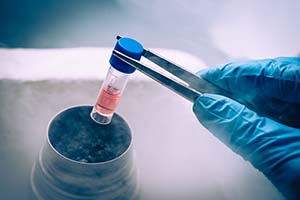
In vitro fertilization (IVF) is one of the most widely performed fertility treatments. IVF is an assisted reproductive technology that assists with many stages of conception to increase the chance of pregnancy. IVF has a high rate of success, allowing many who have struggled with infertility to start a family.
At Arizona Associates for Reproductive Health, IVF is also offered as an option for fertility preservation, which allows our patients to plan for the future. Individuals in the Scottsdale, AZ, and Gilbert, AZ, area can learn how IVF for fertility preservation makes it possible to start a family on your own timeline, or to preserve fertility in the face of illness or cancer treatment.
Many people believe that fertility treatment is solely for individuals who are actively trying to conceive, but it also allows people to preserve their fertility so that they can have a child when they are ready, without worrying that their fertile health has declined. Fertility preservation is ideal for individuals who want to wait until later in life to start a family, those who are experiencing medical issues that could impact fertility, or those who need to undergo medical treatment (such as radiation or chemotherapy) that can affect fertility.
Egg and embryo freezing are common fertility preservation techniques. Egg and embryo freezing is achieved through IVF treatment. IVF treatment for fertility preservation takes place in several stages, starting with ovarian stimulation.
When performing IVF for fertility preservation, the goal is to freeze as many viable eggs or embryos as possible, which means that we need to start with multiple eggs. Most women only release one egg per month. To encourage the production and release of multiple mature eggs, we start the IVF process with ovarian stimulation. Ovarian stimulation involves the use of fertility medication to essentially jumpstart the ovaries.
At the completion of ovarian stimulation, patients self-administer a shot of human chorionic gonadotropin (hCG), which is known as the trigger shot. The trigger shot starts ovulation so that eggs are released and can be collected via egg retrieval. During egg retrieval a small hollow needle is inserted transvaginally. Using ultrasound imaging, the needle is guided to the follicles, where eggs are aspirated into the needle. For egg freezing patients, the process ends at this stage of treatment, and the eggs are cryopreserved for future use.
For embryo freezing patients, the retrieved eggs are mixed with a concentrated sperm sample, which is collected by either the prospective father or a sperm donor. The eggs and embryos are evaluated for several days to see which are successfully fertilized and maturing. On day three or five following fertilization, any viable embryos are flash frozen with liquid nitrogen. Freezing protects and preserves the embryos so they can be used for future IVF treatment.
When a woman is ready to start a family, the eggs or embryos are thawed. Frozen eggs go through the fertilization process, and viable embryos can be transferred. Thawed embryos are transferred directly to the uterus. In either case, the selected embryos are placed in a thin catheter that is inserted through the vagina and into the uterus, where embryos are deposited. Ideally one or more embryos will implant to the uterine lining, resulting in a healthy pregnancy for our patients.
If you are interested in learning more about fertility preservation options, including IVF, the specialists at Arizona Associates for Reproductive Health would be happy to answer any questions you may have. To schedule a personal consultation at our fertility clinic in Scottsdale or Gilbert, send us a message online or call (480) 860-4792 at your earliest convenience.